|
|
|
Sort Order |
|
|
|
Items / Page
|
|
|
|
|
|
|
| Srl | Item |
| 1 |
ID:
121987
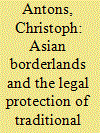

|
|
|
|
|
| Publication |
2013.
|
| Summary/Abstract |
Traditional knowledge related to biodiversity, agriculture, medicine and artistic expressions has recently attracted much interest amongst policy makers, legal academics and social scientists. Several United Nations organizations, such as the World Intellectual Property Organization (WIPO) and the Convention on Biological Diversity under the United Nations Environmental Programme (UNEP), have been working on international models for the protection of such knowledge held by local and indigenous communities. Relevant national, regional or provincial level legislation comes in the form of intellectual property laws and laws related to health, heritage or environmental protection. In practice, however, it has proven difficult to agree on definitions of the subject matter, to delineate local communities and territories holding the knowledge, and to clearly identify the subjects and beneficiaries of the protection. In fact, claims to 'cultural property' and heritage have led to conflicts and tensions between communities, regions and nations. This paper will use Southeast Asian examples and case studies to show the importance of concepts such as Zomia, 'regions of refuge' and mandala as well as 'borderlands' studies to avoid essentialized notions of communities and cultures in order to develop a nuanced understanding of the difficulties for national and international lawmaking in this field. It will also develop a few suggestions on how conflicts and tensions could be avoided or ameliorated.
|
|
|
|
|
|
|
|
|
|
|
|
|
|
|
|
| 2 |
ID:
103657
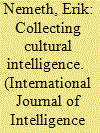

|
|
|
| 3 |
ID:
076655
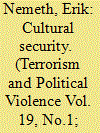

|
|
|
| 4 |
ID:
170433
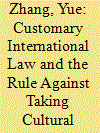

|
|
|
|
|
| Summary/Abstract |
Many countries seek to regain lost cultural property that was taken as spoils of war during the nineteenth and early twentieth centuries. Some scholars, however, regard such claims as baseless in public international law of this period. This article carries out an intertemporal law analysis and argues that the rule against such plunder was indeed founded in the laws and customs of war in the eighteenth century, became well established in the nineteenth century, and further developed in the twentieth century. If the plundered works exist and are identifiable, restitution is the only remedy for violation of this rule. This article aims to provide the legal grounds for restitution claims and thus provide the first steps for victim States to regain their lost cultural property.
|
|
|
|
|
|
|
|
|
|
|
|
|
|
|
|
| 5 |
ID:
093876
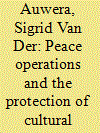

|
|
|
|
|
| Publication |
2010.
|
| Summary/Abstract |
Since armed conflicts are based increasingly on politics of identity, the protection of cultural property is likely to become continuously more important during peace operations. The extent to which peace operations are obligated to protect cultural property is, however, not always clear. This article explains why and to what extent peace operations ought to be required to protect cultural property. It first explores the way that the protection of cultural property can contribute to the overall aim of an operation. Second, the extent, from a legal standpoint, to which peace operations must respect cultural property is elaborated - and whether peace operations must refrain from damaging cultural property. Finally, the article analyses whether peace forces are obligated by international law to actively protect cultural property. Thus, whether they are responsible for the protection of cultural property from the depredations of others is questioned. The study contends that, on the one hand, the protection of cultural property is needed because it contributes to the overall aim of a peace mission, but that, on the other hand, a coherent legal framework is lacking.
|
|
|
|
|
|
|
|
|
|
|
|
|
|
|
|
|
|
|
|
|